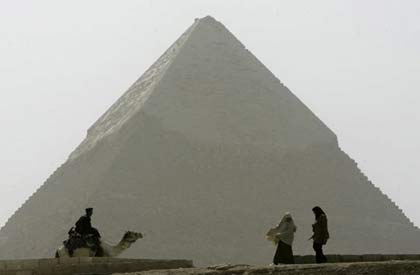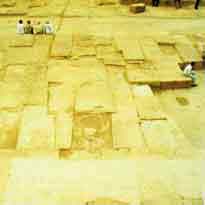Pyramid built from stone blocks ... fake!
According to Egyptian experts, the Maadi area is a place to supply stone for the construction of pyramids. But the chemical composition of limestone here is quite different from the stone samples extracted from the pyramids.
In 2001, French Science & Vie published a controversial hypothesis: the pyramids in Gizeh (Egypt) were not built from natural blocks of stone and elaborately cut, but Actually, it is from prefabricated concrete blocks! Then five years later, a physicist and a material expert confirmed this idea. So, is it possible since ancient times, Egypt had a team of outstanding chemists?
Science is " engaged " in the specialization of Egypt: a few rock formations, at least look like that, taken out of the pyramid and are taken by some scientists to compare carefully with many Different stone samples are taken from a few areas near this magnificent and magnificent building. Result: two specimens have a very different difference. And the question arises!
For decades, even for centuries, there have been many claims that the pyramids at Gizeh were actually constructed from chemically treated and molded limestone. to get massive " stone " blocks like we see today. In recent years, many material experts are very interested in this issue. They observed and analyzed the stone samples and concluded that the artisans of Egyptian pharaohs were very proficient in the art of artificial stone making!

(Photo: Discovery)
According to these experts, the Egyptians then used chemical treatment methods to make a " concrete " called geopolymer to build tombs for their kings. But so far, there are still many historians studying Egypt who always defend their own point of view that materials to build pyramids are natural blocks of stone taken from the near high Toura and Maadi areas. former Gizeh and was elaborately cut by hand. The debate has not yet ended.

1- Although the angles are not uniform, it seems that the stones are arranged very well.So how can the natural masses that weigh many tons can be so elaborate? This image immediately creates the feeling of a building entirely made of molded " concrete " blocks rather than from natural stones.
Natural stone or artificial stone? Now it is the turn of a material science physicist at the Aerospace Research Institute at Châtillon (France) and a professor of material science at Drexel University (Philadelphia, USA) to review the problem. threads. Later, scientists Gilles Hug and Michel Barsoum claimed that part of the many blocks of stone built in Gizeh's large pyramids were made of natural limestone but chemically treated by humans. and then compressed into large blocks.
Starting from the trace of a chemical reaction
Professor Gilles Hug presented: "We compared the composition of natural limestone samples from the Toura and Maadi areas with the stone samples of Kheops pyramid, and discovered some signs. weirdo". According to him, the first is: the composition of the stone in the pyramid is much more complicated than natural stone. This also coincides with the observation of some authors who studied this problem in 2002, claiming that some of the microelements of the pyramids have remnants of a fast chemical reaction, which has This means that this stone foundation is not real stone formed after a natural crystallization process.
They further explained that, if it was natural stone and cut, it would be impossible to have a quick form of chemical reaction inside the rock . But if these stones are blended by human hands from powder and mixed into water to form liquid and eventually solidify in the mold, like the process of making concrete, this form of quick chemical reaction It is entirely possible.
Still the opinion of Professor Gilles Hug: "Therefore, the stones used to" coat "outside Kheops pyramid have a much higher silica content than natural stone samples taken from Toura area, where It is thought that we have provided the material to build this pyramid, and that the outer rocks also contain a greater amount of magnesium than natural stone samples, so from the initial observations we have Some of the parameters are very convincing, but we have not been able to affirm absolutely anything. "

2- The gap between the stones is very sophisticated, making the experts always question: one side thinks that this is the talent of the ancient people, while others say this is the result of a shrinkage of concrete materials when dried…
One more surprising thing: some of the micronutrients in the pyramid's rock form are thought to be " amorphous " or "non-crystalline". Prof. Michel Barsoum said: "In natural stone, there will be material components that can only crystallize after going through a very long time. It is normal for a block of stone to be formed. But in those pyramids, the micronutrients were formed very quickly, after only a period of time I thought it was very short, maybe they hardened themselves at low temperatures before there were crystals. This phenomenon in nature is impossible, except in the case of volcanic eruptions, but the volcano here is a excluded phenomenon. let us think of a chemical process at low temperatures to get those artificial stones. " Eventually, the scientist agreed that Egyptians must have had a team of talented chemists.
But so far, many experts on Egyptology are still skeptical. Mr. Sydney Aufrère of the Research Institute for "Christian Societies and Society" of the French National Center for Scientific Research (CNRS) said: "My view on building self-made pyramids Because at the construction site, the Egyptians had enough materials in place at the same time, and there was a large workforce and appropriate technical facilities. Why do they have to work hard to invent something more costly? ".
Scientists still need more new samples
In fact, it is not only geographic and chemical analyzes that can justify the hypothesis that these rocks might have been made in a very artificial way. Just by looking outside can also help this hypothesis exist. A concrete example: the joints between rock blocks are perfect and sentences

3- The upper surface of many rock masses is structured as a porous body.According to materials experts, that is the result of the emergence of air bubbles and light physical components during the " concrete " freezing process.
The question is: How would it make sense to reasonably think that tons of heavy, natural stones could be elaborately and meticulously polished? It has been suggested that each of these artificial blocks has already been " built up " before, that is, crafted in the mold, so that the architects are right according to the size and position. I want to install it at the time.
When observing in the field, experts believe that the abrasive effect is very obvious in the upper part of the blocks, while the bottom is not. According to chemical expert Joseph Davidovits, this phenomenon is quite simple: during the mortar mixing process, heavy materials will settle to the bottom. Therefore, the lower part of the rock will be more "concentrated" and less eroded. The same is true of the type of concrete we use today. Therefore, it is now possible to add fresh concrete with an additive to stabilize the composition of the mixture before it freezes. This is the only thing that the Egyptians probably didn't know at the time!
However, in order to prove clearly and convincingly the hypothesis of the pyramids of "pyramids", the team of research specialists must be approved by the local government, officially allowing they came to take more necessary stone samples from many places inside the pyramid to analyze it more thoroughly. But so far, the application for permission to continue conducting the collection of rock samples in the pyramids was rejected by the Egyptian government or deliberately forgotten. And the scientists have to wait a while longer!
Try making concrete in the way of ancient Egyptians!
Research institute of chemistry and Egyptology professor Joseph Davidovits conducted a reconstruction of the process of making " concrete " to build the pyramid:

1. Use limestone that has the same composition as limestone in Gizeh area
2. Materials of limestone are crushed and mixed with some other substances such as caustic soda, lime and clay containing kaolin, in a water tank with a capacity of 2,000 liters
3. After 3-4 days, evaporation and geopolymer materials are completed, looking like a mixture of sand and mud
4. This mixture is compressed into the mold and will dry itself hard after 10 days
5. After removing the mold, those " stone " blocks will fit perfectly together. After only months, the gap between the " concrete " blocks was exposed
Manh Hung
How Egyptians make concrete
1. Exploiting salt from temporary rivers in the desert after it has dried up. This amount of salt is then collected in a separate area
2. Harness palm trees and burn them to get the ashes. This ash is rich in calcium oxide and used to add salt
3. The mixture of ash and salt is mixed into the water to obtain a caustic material.
4. After that, the limestone will be added to this caustic to finally get a complete construction material
5. The finished construction material mixture will look like a paste but very strong
6. Finally, salt is added again to reduce the pH in the construction mixture.The workforce will move this mixture to the position to be built, put it into the formwork, close the mold and wait until a block of "concrete" is complete and shaped like it is frozen.
- Discover the largest ancient stone by humans
- Shocking discovery of the true color of the pyramid
- Pyramids cost 5 billion USD
- The truth after the Giza Pyramid Project
- Revealing secrets of Truong Yen ancient stone block
- Uncover the mysterious pyramid construction in just 1 night
- Materials to help the ancient people transport tons of stone built Stonehenge
- Mysterious around the oldest pyramid in Egypt
- The Great Pyramid of Giza can be built on top of a huge natural hill
- Strange rock blocks like human heads, solid-bodied fish
- The ancient pyramid appeared in Mexico
- Egypt launches the pyramid project with a radar scanner
 Discovered an ancient centipede fossil 99 million years old
Discovered an ancient centipede fossil 99 million years old Discovered bat-like dinosaurs in China
Discovered bat-like dinosaurs in China Discovered a 200-year-old bronze cannon of the coast
Discovered a 200-year-old bronze cannon of the coast Discover 305 million-year-old spider fossils
Discover 305 million-year-old spider fossils